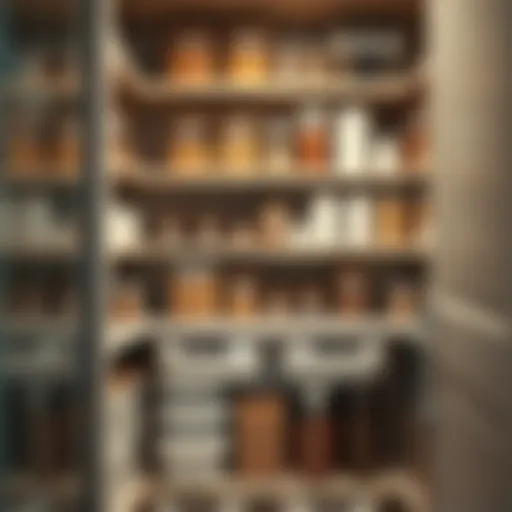Stainless Steel Shelving Units: Kitchen Advantages
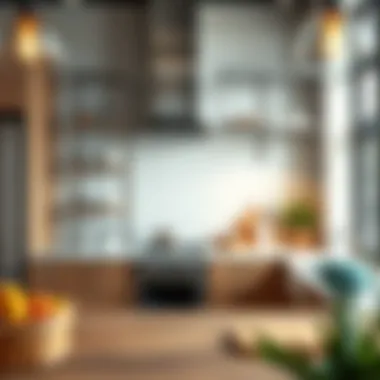

Intro
In the heart of every home, the kitchen stands as a sanctuary for culinary passion and creativity. It's not just a place to prepare meals, but a functional space where memories are made. When it comes to setting up this vital area, stainless steel shelving units have carved a niche for themselves. Offering a blend of functionality and modern aesthetics, they hold the promise of enhancing both organization and visual appeal. This piece will take a close look at these shelving units, providing insights into their durability, design options, and their role in maximizing kitchen efficiency.
Furniture Styles and Trends
Stainless steel shelving units can fit into various decor styles within a kitchen, but understanding the landscape of furniture trends can help homeowners and designers make more informed choices.
Modern vs. Traditional: Understanding the Aesthetics
The appeal of stainless steel lies not just in its practicality but in its versatility across differing styles. In modern kitchens, where minimalism reigns supreme, stainless steel shelving fits right in. The shimmering finish paired with clean lines can create an uncluttered and sleek look. On the flip side, traditional kitchens, often accentuated with wood and antique finishes, can also benefit from stainless steel units. Here, the juxtaposition of metal against wood can add character without overshadowing the home's warmth. This blend of materials offers a refreshing contrast that draws eyes without overwhelming the overall aesthetic.
Color and Material Trends: What's In and What's Out
When selecting stainless steel shelving, it's essential to keep an eye on color and material trends. Currently, muted tones, including matte black and brushed nickel, are gaining traction for a more understated elegance. These shades can provide a sophisticated backdrop, allowing the vibrant colors of kitchen items to pop. Moreover, incorporating mixed materials—like combining wood elements with stainless steel—has gained popularity, as it aligns well with the rising trend towards biophilic design. This approach seeks to connect the indoors more harmoniously with nature, using materials that reflect those elements.
Furniture Care and Maintenance
Once you've installed your stainless steel shelving, understanding how to maintain them is crucial to prolonging their lifespan and beauty.
Tips for Prolonging the Life of Your Furniture
- Regular Cleaning: A simple mix of warm water and mild detergent is all you need for upkeep. Avoid abrasive scrubbers to prevent scratches.
- Avoid Harsh Chemicals: Stay away from bleach and ammonia-based cleaners which can damage the finish.
- Watch for Rust: Although stainless steel is resistant, it isn't invincible. Keep an eye out for rust spots and treat them immediately with a gentle abrasive pad.
DIY Repair Hacks for Common Furniture Issues
Even the sturdiest shelving units may face wear and tear over time. If you notice scratches or dents, don't fret. For shallow scratches, a bit of stainless steel polish can work wonders in restoring that shiny finish. For larger issues, consider using a soft cloth and a bit of fine grit sandpaper, rubbing in the direction of the grain to minimize visibility.
These hacks are invaluable as they not only save money on professional repairs but also give homeowners a sense of satisfaction in maintaining their space.
"The right shelving can transform a cluttered kitchen into an organized haven, merging style, efficiency, and design into one accessible solution."
Ultimately, stainless steel shelving units can provide a solid foundation, enabling homeowners, designers, and avid cooks alike to showcase their essentials while keeping the kitchen looking sharp.
By merging functionality with a modern aesthetic and understanding how to care for these valuable assets, kitchens can evolve into more than just workspaces—becoming areas where art and life merge beautifully. For more on design trends, check out resources like Wikipedia and Britannica.
Prologue to Stainless Steel Shelving
When it comes to organizing the heart of the home, stainless steel shelving units are becoming a go-to choice for many. The kitchen is a space where efficiency meets style, and incorporating stainless steel not only elevates aesthetics but also enhances functionality. This article delves into the intricacies of stainless steel shelving, demonstrating its importance in modern kitchen designs.
Stainless steel isn’t just about appearance; it’s a strategic selection for homeowners and designers alike. The rising trend towards more utilitarian spaces makes understanding this material critical, as it brings a harmonious blend of durability, safety, and ease of maintenance. Considering the nature of kitchens—frequent spills, heat exposure, and the need for cleanliness—this material stands out as ideally suited for the environment.
Overview of Stainless Steel as a Material
Stainless steel, an alloy composed chiefly of iron, chromium, and nickel, is renowned for its remarkable properties. The inclusion of chromium provides a protective layer that keeps the metal from rusting or staining. Unlike conventional steel, stainless steel's ability to resist oxidation makes it exceptionally valuable in high-traffic areas like kitchens. Not only does it boast a sleek surface that can match various design aesthetics, but it also supports an environment where hygiene is a priority. In today’s busy lifestyles, if you’re after a mix of form and sustenance, stainless steel is the name of the game.
Benefits of Using Stainless Steel in the Kitchen
The practical advantages of stainless steel are manifold. Here are some standout characteristics that cement its status in kitchen storage solutions:
Durability and Longevity
One of the hallmark traits of stainless steel is its toughness. This material can withstand not only daily wear but also harsh conditions including temperature changes and chemical exposure. Durability means less frequent replacements, which results in savings in the long run. This remarkable strength keeps furniture intact even in the fray of cooking activity. For instance, a stainless steel shelving unit can support heavy kitchen gadgets without bending or buckling over time. Such longevity is a standout feature that appeals to both consumers and designers.
Resistance to Corrosion
The corrosion resistance of stainless steel is perhaps its most significant selling point. In a kitchen where moisture from cooking and washing is a constant, having materials that can fend off rust is crucial. Resistance to corrosion not only extends the life of your shelving units but also ensures they maintain their luster and integrity. It’s not merely about aesthetics; it’s about maintaining a sanitary environment too. Food particles and moisture can cause havoc if left unchecked, but stainless steel helps keep the kitchen pristine. This unique attribute gives homeowners confidence that their investment won’t succumb to environmental wear and tear.
Ease of Cleaning
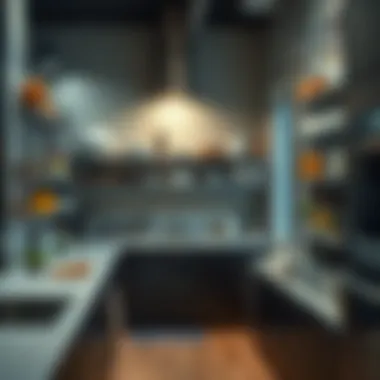

Another appealing aspect of stainless steel is its ease of cleaning. A quick wipe down with a damp cloth and mild detergent is usually sufficient to keep it looking brand new. Food stains and marks are easily removable, which is a significant plus in a space known for its culinary experiments. Moreover, since it doesn’t harbor bacteria, stainless steel contributes positively to the overall hygiene of the kitchen. It’s this straightforward maintenance coupled with its functional design that makes stainless steel shelving units so necessary in contemporary kitchen settings.
In summary, the merits of stainless steel extend beyond simple hardware; they encompass durability, resistance, and maintenance ease. As we move forward in the article, we will explore design considerations, practical applications, and installation tips for stainless steel shelving—paving the way for a well-organized and efficient cooking space.
Design Considerations for Stainless Steel Shelving
When it comes to integrating stainless steel shelving in your kitchen, there are several design considerations that shouldn't be overlooked. The choice of shelving units can greatly influence both the aesthetic appeal and functionality of your kitchen. Understanding how to align these choices with your kitchen's style and purpose is paramount. From selecting the right fit to understanding the pros and cons of custom compared to pre-made units, careful thought can offer you a practical and pleasing outcome.
Compatibility with Kitchen Styles
Modern and Contemporary Kitchens
In modern and contemporary kitchens, stainless steel shelving often shines as a symbol of sleek minimalism and sophistication. One key characteristic of these styles is the emphasis on clean lines and simplicity. Stainless steel units complement this by providing not only a utilitarian solution but also enhancing the overall aesthetic with their reflective surfaces. This reflective quality can make space feel more open and bright, a substantial advantage in smaller kitchens where maximizing light is crucial.
Moreover, modern kitchens often incorporate various textures and materials, making stainless steel a versatile choice. It can contrast beautifully with wood accents or sleek granite countertops, contributing to a balanced design. What’s more, these kitchens often feature an open concept layout, where the visibility of materials plays a significant role. Choosing stainless steel not only brings functionality but also allows you to showcase your kitchenware in an organized manner, contributing to a cohesive design.
Industrial and Rustic Designs
Now, let’s pivot to industrial and rustic designs, which embrace a more raw and organic aesthetic. The key element here is the use of materials that showcase craftsmanship and a back-to-basics vibe. Stainless steel shelving fits well within this framework, as it offers both strength and a rugged charm when paired with wooden surfaces or exposed brick walls. One unique aspect of this blend is how it marries modern functionality with rustic warmth, creating a kitchen that feels both lived-in and organized.
In rustic settings, the durability of stainless steel offers practical benefits: it’s resilient against spills and scratches, which is not always the case with wood or glass alternatives. However, a potential downside is the coldness that metal can bring to the overall feel of a kitchen. To mitigate this, carefully chosen decor items or wood elements can soften the industrial edge, creating a welcoming environment while still benefiting from the utility of stainless steel shelving.
Custom vs. Pre-Made Units
When deciding between custom and pre-made shelving units, it’s crucial to consider your specific needs and circumstances. Custom units offer the advantage of tailored dimensions, ensuring your shelves fit seamlessly into constrained spaces while maximizing functionality. For unique kitchens with non-standard dimensions, custom shelving can guarantee a perfect fit. However, this option can come with a higher price tag and a longer installation process.
On the other hand, pre-made units offer a ready-made solution that can be more budget-friendly and quicker to install. These units come in various styles and sizes to suit different kitchen themes. While they might not perfectly match your kitchen's dimensions, there are often enough options to find a feasible alternative that aligns with the overall design.
Deciding on the type of shelving units often boils down to balancing your budget, timing, and specific needs. Whether you lean toward custom or pre-made, recognizing the impact of your choice on your kitchen’s aesthetics and functionality will certainly set the foundation for a successful design.
Practical Applications in the Kitchen
Stainless steel shelving units provide a practical solution for the chaotic realm of kitchen organization. Their blend of functionality and aesthetics makes them a go-to choice for those striving for order while maintaining a polished appearance within their culinary spaces. In kitchens, where every inch counts—especially in smaller environments—these shelves stand out for their versatility. They serve not only as a means to store and showcase but also as a way to enhance overall kitchen efficiency.
Storage Solutions for Kitchen Tools and Ingredients
Utilizing Vertical Space
Maximizing vertical space is a game changer for any kitchen. Tall shelves can reach up to the ceiling, freeing up valuable counter space. By stacking and layering items upwards, you’ve got access to additional storage without compromising floor area. This approach can amplify organization, making it easier to find pots, pans, or ingredients without digging through clutter.
The fantastic characteristic about utilizing vertical space is the opportunity to keep frequently accessed items within arm’s reach while placing less-used items higher up. For example, you can store bulk items or seasonal tools on upper shelves while keeping everyday utensils at eye level. This arrangement not only saves space, but it also ensures that your kitchen looks tidy and well-planned. However, it’s essential to note that reaching high shelves may necessitate a step stool, posing potential challenges for some users.
"Vertical space in a kitchen is every bit as important as counter space. When you utilize it effectively, you can unlock a realm of organizational possibilities."
Organizing with Baskets and Containers
Integrating baskets and containers into stainless steel shelving transforms a space into an organized oasis. It adds an extra layer of functionality while providing a customizable touch. With a range of materials and colors, these storage solutions cater to diverse tastes, allowing homeowners to express their personal styles while keeping clutter at bay.
Baskets can hold smaller tools or packets of spices, making them both aesthetically pleasing and practical. An important factor here is that they make it easier to sort and retrieve items as needed. Say goodbye to rummaging through a jumbled mess; instead, each category of item has its designated compartment. However, there can be a downside; improper sizing or mismatched styles may disrupt the overall visual harmony of the kitchen. So choosing the right fit and style is key.
Showcasing Kitchenware and Decorative Items
Beyond mere storage, stainless steel shelving offers a fantastic canvas for showcasing your favorite kitchenware and decorative pieces. The sleek, reflective surfaces of stainless steel provide a striking backdrop that elevates the ordinary to the extraordinary. Brightly colored dishes or handcrafted pottery can pop against the stainless backdrop, creating an eye-catching display.
Moreover, the visibility of showcased items tends to inspire culinary creativity. Seeing your collection often encourages experimentation; you might be more inclined to use that unique ceramic pitcher for its intended purpose instead of leaving it as a mere ornament. Still, be aware that not everything is suited for display. Heavy or oddly shaped items may not lend themselves well to shelving, and careful consideration of weight distribution is essential to prevent accidents.
Installation of Stainless Steel Shelving Units
Installing stainless steel shelving units in your kitchen can transform your space into a more organized and visually appealing environment. It’s not just about putting up some shelves; it’s about creating a functional area that enhances your workflow while ensuring everything has its place. A properly installed shelving unit can take advantage of vertical space, keep your kitchen tidy, and provide a stylish touch that suits any design . This section provides insights into both the tools you'll need and a step-by-step guide to ensure a seamless installation process.
Tools Required for Installation
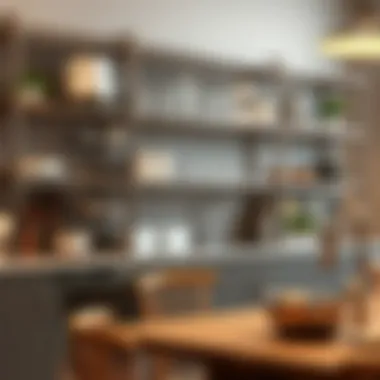

Before rolling up your sleeves, you need to gather the right tools. Having everything at hand can make the installation smoother and helps in avoiding unnecessary trips to the hardware store mid-project. Here’s a list of the essential tools:
- Level – Ensures your shelves are straight.
- Drill and Drill Bits – You’ll need these to create holes for wall anchors or screws.
- Stud Finder – For locating wall studs to secure your shelves properly.
- Screwdriver – A basic Phillips or flathead will come in handy.
- Tape Measure – Measuring is key to planning where your shelves will go.
- Pencil – For marking measurements without leaving permanent marks.
- Wall Anchors – If you can't affix your shelves directly into a stud, these will help secure the shelving unit.
- Safety Glasses and Gloves – Always prioritize safety when doing home installations.
With these tools at your disposal, you are well on your way to setting up your stainless steel shelving units with confidence.
Step-by-Step Installation Guide
Once you've got the tools, it's time to dive into installation. Here's a straightforward guide to help you get those stainless steel shelves up:
- Identify the Location: Choose where the shelving unit will go. Be sure to consider accessibility and visibility.
- Use the Stud Finder: Go ahead and use the stud finder to locate the wall studs. Typically, installing shelves anchored to the studs ensures maximum stability.
- Measure and Mark: Use the tape measure to mark where the brackets will be installed. It's crucial to ensure the shelves are level, so don’t skip this step.
- Drill Holes: With the drill, carefully make holes at the marked locations. Remember to assess your wall type; drywall requires different anchoring compared to concrete or brick.
- Insert Wall Anchors: If necessary, insert the wall anchors into the holes you just drilled. This will provide a better hold for your shelving brackets.
- Attach the Brackets: Align the brackets with the holes or anchors and secure them using the screws and screwdriver.
- Install the Shelves: Finally, place the stainless steel shelving units onto the brackets. Give a gentle push and check once more with the level to confirm everything is even.
- Final Touches: Tighten any screws and step back to appreciate your work. Make sure there are no wobbling parts, and adjust if necessary.
"Installation isn't just about getting it up on the wall; it's about ensuring it serves you well for years to come."
With this guide, you should find yourself equipped to tackle the installation of stainless steel shelving units like a pro. Taking the time to do it right can save headaches later. Remember, an organized kitchen isn’t just about aesthetics; it’s about improving your cooking experience.
Maintenance and Care for Stainless Steel Shelving
Taking care of stainless steel shelving is crucial for preserving its integrity and appearance. Regular maintenance not only enhances longevity but also keeps your kitchen looking sharp. Proper care ensures that these units can withstand the hustle and bustle typical in a kitchen environment, where spills and heat can take their toll. Understanding how to maintain your stainless steel shelves effectively can save you money and keep your kitchen in tip-top shape.
Regular Cleaning Practices
Recommended Cleaning Agents
When it comes to cleaning stainless steel, choosing the right cleaning agent is half the battle. Popular options include mild dish soap mixed with warm water, vinegar, or dedicated stainless steel cleaners. The key characteristic is their non-abrasiveness, meaning they won't ruin the surface or create scratches over time. Using vinegar can be particularly effective due to its natural antibacterial properties. Moreover, specialized cleaners often include protective ingredients that repel dirt and fingerprints, maintaining a polished look.
However, caution is needed. Some agents can leave behind a residue or dull the finish if not rinsed properly. Always make sure to use a soft cloth or sponge while applying these cleaners. They offer a friendly, eco-conscious cleaning solution ideal for busy homeowners. While they are generally safe, it’s best to avoid any harsh chemicals like bleach, which can lead to corrosion.
Preventing Scratches and Dents
Preventing scratches and dents is another vital aspect of maintaining stainless steel shelving. The material is resilient, but it's not invincible. A common practice is to avoid dragging heavy objects across the surface. Instead, picking them up can save your shelves from unsightly marks. The key here is to be gentle; even small actions can either protect or mar the beauty of your shelving.
Unique features of stainless steel, such as its heat resistance, don't mean it can withstand everything. For instance, placing hot pots directly on shelves may cause warping over time. Using mats or trivets can further enhance protection. It's often said that an ounce of prevention is worth a pound of cure, and that rings especially true for maintaining these units.
Long-Term Care Tips
Consistent care isn’t just to keep things desirable; it sets the foundation for lasting function. Apart from regular cleaning and preventing damage, there are additional steps for long-term care that deserve attention.
- Routine Inspections: Regularly checking shelving units for signs of wear and tear can identify potential issues early.
- Avoiding Harsh Scrubbing: Using metallic scrubbers can ruin the finish, so stick to soft sponges and cloths.
- Using Approved Coatings: Some users find that applying a light layer of mineral oil can help preserve the sheen and make cleaning easier.
- Proper Installation: Ensuring that the shelves are correctly installed can help distribute weight evenly, preventing sagging and unnecessary stress on brackets.
With this maintenance knowledge in tow, stainless steel shelving units can remain not only a practical storage solution but also a stylish addition to your kitchen.
Advantages Over Other Material Options
When thinking about how to make the best use of space in the kitchen, the material choice for shelving is paramount. Stainless steel is often overlooked in favor of wood or glass, but its unique strengths should not be underestimated. This section will delve into how stainless steel shelving units compare to more traditional materials, including wood and glass, ultimately showcasing why stainless steel stands out in the long run, especially in a demanding environment like the kitchen.
Comparing Wood, Glass, and Metal
When assessing shelving materials, wood, glass, and metal bring their own advantages and challenges. Let's explore these:
- Wood Shelving: Known for its warmth and natural appeal, wood shelves can certainly enhance the aesthetic of a kitchen. However, they are often susceptible to moisture, which can warp or rot over time. This makes them less ideal in high-humidity kitchen environments.
- Glass Shelving: This option provides a modern and sleek look. It's excellent for displaying fine china or spices. However, glass can shatter, making it a less practical choice in a busy kitchen where heavy items are stored.
- Metal Shelving: Stainless steel, specifically, is resistant to rust and corrosion. Unlike wood, it doesn't absorb moisture and maintain its integrity in humid conditions, making it a solid investment for durability.
Thus, one can say that while wood and glass have their merits, the practicalities of using stainless steel truly shine through.
Cost-Effectiveness in the Long Run
It’s easy to consider the price tag of materials upfront, but true cost-effectiveness should account for longevity and maintenance. Here’s how stainless steel shelving units stack up:
- Initial Costs: Stainless steel shelving may have a higher initial cost compared to wood, but their durability and resistance to elements such as humidity and heat means lower replacement costs down the line.
- Maintenance: Maintaining wood often involves periodic treatments and sealants to protect against the elements. In contrast, stainless steel requires minimal upkeep—just a simple wipe down every now and then. This leads to lower lifetime expenditures on cleaning supplies and potential repairs.
- Resale Value: A kitchen that features durable and visually appealing stainless steel shelves can significantly increase a home's value, making it a wise investment for homeowners looking at long-term benefits.
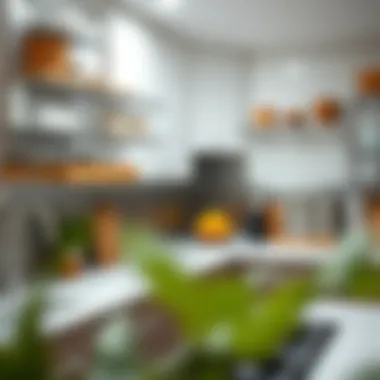

Trends in Kitchen Design Featuring Stainless Steel Shelving
As we venture into the realm of kitchen design, the presence of stainless steel shelving units plays an ever-growing role. These units not only offer substantial functionality but also bring a sleekness that can elevate the overall aesthetic of the kitchen space. The importance of this topic in the current design landscape cannot be understated. Stainless steel is a material that aligns remarkably with contemporary trends, combining form and function effortlessly.
Minimalist Approaches
Minimalism in kitchen design has been a hot topic over recent years. The concept is grounded in the philosophy of 'less is more' - a choice to eliminate the clutter and showcase only elements that serve a purpose. Stainless steel shelving fits snugly into this approach. With its smooth surfaces and understated elegance, it creates an impression of cleanliness and order.
- Openness: Stainless steel shelving can promote a sense of openness in the kitchen. Wall-mounted units can keep floor space clear, making kitchens feel larger and more inviting.
- Versatility: These units are adaptable to various kitchen themes. Whether one leans towards a sleek, industrial vibe or a more understated contemporary look, stainless steel's versatility means it can match diverse design preferences.
- Color Scheme Compatibility: The neutral tone of stainless steel can complement both cool and warm color palettes, facilitating seamless integration with cabinetry, countertops, and appliances.
Homeowners are increasingly drawn to this clean-cut aesthetic, often leaving their stainless steel shelves somewhat bare to emphasize their simplicity. Decorative items, like herbs in ceramic pots or glass jars with colorful pasta, can also punctuate the shelves without overwhelming the visual space.
A Blend of Functionality and Aesthetic
The blend of functionality and aesthetic appeal in kitchen design is becoming paramount as culinary spaces evolve into an extension of the home. Stainless steel shelving provides a bridge between practicality and beauty.
- Efficiency in Design: Stainless steel shelving units can enhance workflow efficiency. They allow chefs to access tools and ingredients quickly, minimizing time spent rummaging through cluttered drawers or cabinets. This is particularly beneficial in high-paced kitchens where time is of the essence.
- Durability Meets Beauty: Beyond just a sleek appearance, stainless steel offers durability that outlasts many alternatives. Unlike wood, which can warp over time, or glass that may break, stainless steel stands strong against the rigors of daily kitchen use.
- Customizable Options: Many designers are now creating custom shelving solutions that highlight the uniqueness of each kitchen. Whether it's adding specific size adjustments or integrating lighting into the shelving unit, the potential for personalization ensures that essential functionality can coexist with aesthetic choices.
In this era of informed design, kitchens featuring stainless steel shelving units become more than just cooking spaces; they turn into a canvas where utility meets style. As homeowners and designers push towards creating kitchens that reflect their personality while maintaining high performance, the duo of utility and style will surely see its relevance continue to grow.
User Experiences and Case Studies
When evaluating the utility of stainless steel shelving units in kitchens, the experiences of real users can’t be overlooked. Homeowners, chefs, and interior designers alike provide insights that transcend mere specifications, bringing to light the practical implications of installing such units. Their stories reveal not only the aesthetic enhancement these shelving solutions bring to a kitchen but also the tangible benefits they offer in organization, durability, and ease of maintenance.
Homeowner Testimonials
Homeowners often highlight the transformative effect of stainless steel shelving on their kitchen spaces. One such homeowner, Sarah, a culinary enthusiast, shares how her new stainless steel shelves changed the way she interacts with her kitchen. "Before, I had clutter everywhere. Now, not only can I store all my baking supplies visibly, but I can also access them in a heartbeat," she notes. This sentiment is echoed frequently, as many find that with proper shelving, they eliminate the kitchen chaos that often leads to frustration when cooking or preparing meals.
Consider the feedback from John, who remodeled his kitchen with a focus on functionality. He expresses, "The installation of stainless steel shelving units gave my kitchen a modern flare while serving as robust support for my pots and pans. I never worried about the weight!" This speaks volumes about stainless steel's strength and reliability, allowing homeowners to store heavy items without concern.
In addition to strength and visibility, many testimonials speak to the ease of cleaning. Residents appreciate that these units can simply be wiped down, making one less thing to worry about amid the rigors of daily cooking. As Lisa puts it, "With stainless steel, a little soap and water goes a long way. I love how they sparkle after a quick clean-up!"
These positive experiences illustrate the multifaceted advantages of choosing stainless steel shelving units, providing prospective buyers with a clearer picture of their worth in a practical kitchen setting.
Examples from Interior Designers
Interior designers play a critical role in shaping public perceptions about stainless steel shelving. Their insights often marry functionality with style, further emphasizing why these units can be a centerpiece in modern kitchen design. Designer Rachel M. reveals that she specifically chooses stainless steel for her high-end projects. "They have a minimalistic aesthetic that pairs well with various color palettes and textures," she notes. This versatility assures homeowners that they won’t have to compromise style for utility.
Moreover, designers often highlight how adjustable stainless steel shelves can be tailored to individual needs. Mike, an interior designer specializing in small spaces, states, "In compact kitchens, we often use floating stainless steel shelves. They offer not just storage but also visual depth, making the space feel larger."
The ability to customize these shelving units aids in creating unique designs tailored to fit personal tastes or specific design schemes. Viewers can find examples of this customization on platforms like Pinterest or Instagram, where designers often showcase their work. Many clients have been thrilled at how these shelves can function as both storage and a display area for decorative pieces.
Ultimately, user experiences and designer insights serve as a compass for anyone considering the integration of stainless steel shelving. Each testimony adds color and depth to the understanding of how these units contribute to both the functionality and aesthetics of a kitchen — essential insights that make a compelling case for their adoption.
In the words of a satisfied chef, “Stainless steel shelving isn't just a choice; it's an upgrade — one that speaks to both efficiency and elegance in the kitchen.”
Closure
In wrapping up our exploration of stainless steel shelving units in the kitchen, it becomes abundantly clear that these fixtures are not just a functional choice but rather an indispensable element for any modern culinary space. The importance of utilizing stainless steel shelving in a kitchen cannot be overstated. Its unique properties offer an array of benefits that extend beyond mere aesthetics. The resilience against wear and tear, coupled with inherent resistance to rust and corrosion, ensure longevity. This means homeowners invest in a solution that not only meets their storage needs but stands the test of time.
Moreover, having a well-organized kitchen can have a direct impact on culinary efficiency. Stainless steel shelving aids in maximizing space, especially in smaller kitchens where every inch counts. By opting for adjustable units, one can customize the layout according to their personal requirements, thus enhancing both functionality and convenience.
Beyond practicality, the sleek and polished appearance of stainless steel can elevate the overall look of any kitchen. When choosing to incorporate these units, one considers not only the utility aspect but also how it complements or contrasts with existing design elements.
Final Thoughts on Stainless Steel Shelving
When you take a step back and reflect on the role of stainless steel shelving, it’s apparent that this material is a game changer. From the ease of maintenance due to its non-porous surface to the understated elegance it brings to the table, stainless steel shelving fulfills varied roles. It’s more than about storing pots and pans; it’s about making a statement and offering a practical solution to common kitchen dilemmas.
For many homeowners, upgrading to stainless steel shelving represents a move towards a more professional and organized kitchen environment. Simple yet elegant, these units can effectively display decorative dishware or become the repository for essential cooking tools. The versatility of stainless steel allows for innovative designs, accommodating both traditional and contemporary settings without breaking a sweat.
Encouragement to Consider Aesthetic and Functionality Together
It's vital for homeowners and designers alike to understand that the best kitchen setups achieve harmony between aesthetic appeal and utility. Stainless steel shelving embodies this duality brilliantly. Why sacrifice style for function when you can have both? When planning your kitchen layout, think about how your shelving choices can reflect your personality while also serving practical needs.
Take time to explore various designs and configurations that can enhance the emotional impact of your kitchen. Whether it's the clean lines of an industrial style or the warm juxtaposition of rustic accessories against cool metal, the options are endless. Pay attention to how shelving interacts with other kitchen components, like countertops or cabinetry, to ensure a cohesive look.
In the quest for efficiency and sophistication in kitchen design, stainless steel shelving emerges as a compelling avenue. Put simply, it’s not just storage; it’s part of the culinary canvas that tells your home’s cooking story.















